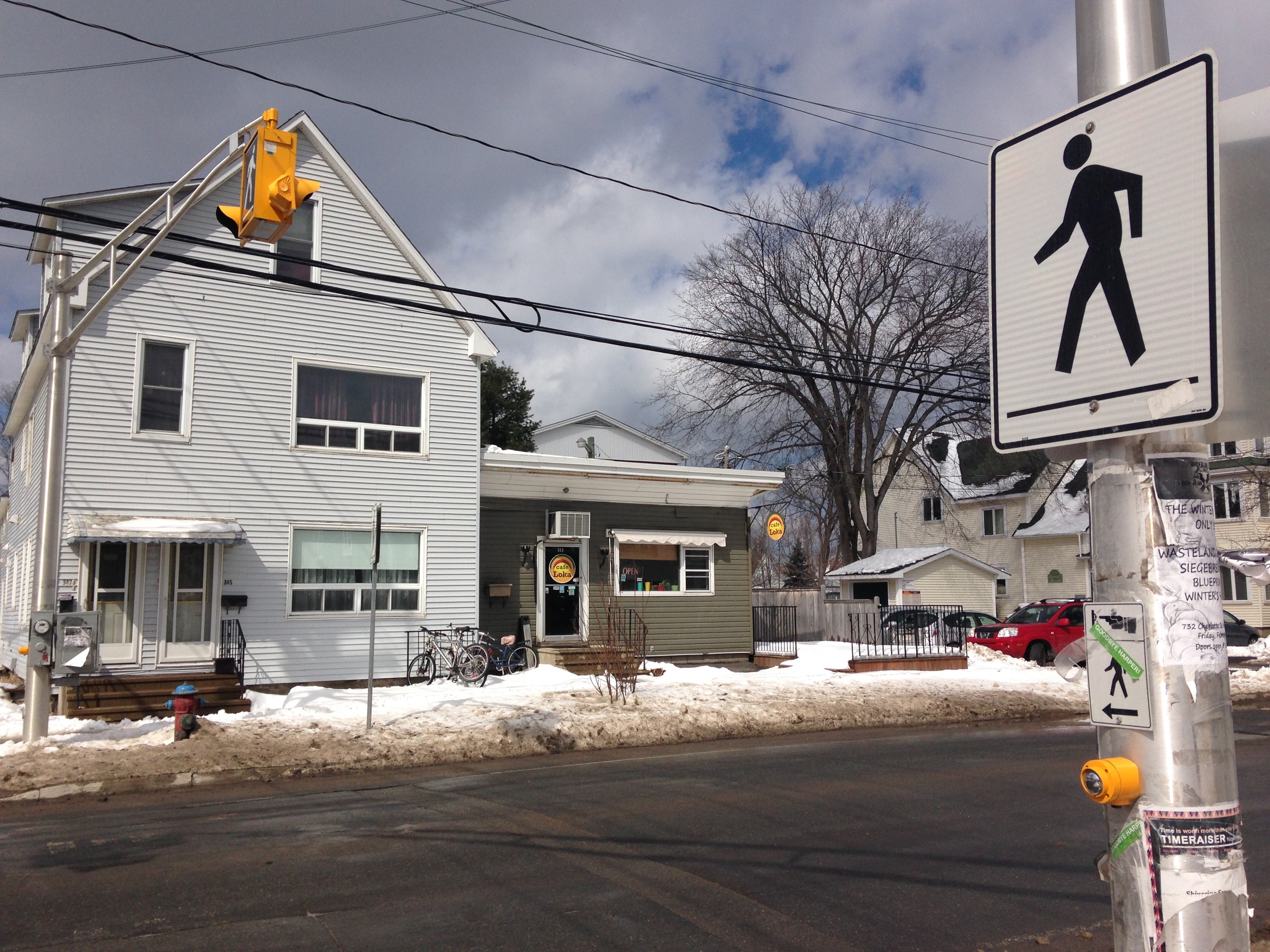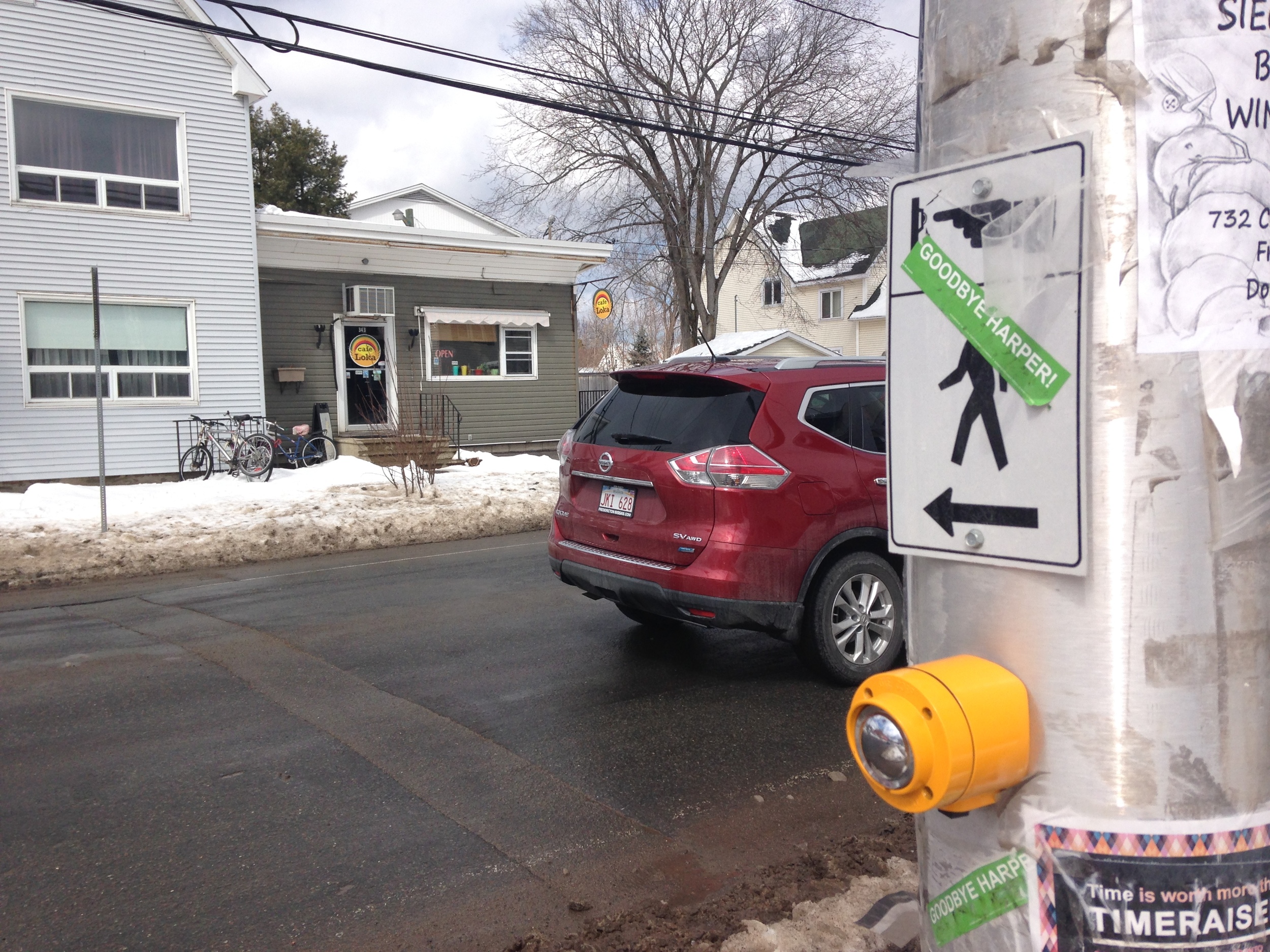Please, do not build that crosswalk.
Our city has a real stinker of a road running through downtown. BUT, for a few hours every week, one small part of that road becomes people-friendly because the farmer's market creates natural traffic calming. Rather than letting the weekly pedestrian habits carry on as they have forever, our city has recommended funnelling pedestrians into a signalized crosswalk so they can wait their turn to cross the street in an approved manner. I believe that is the wrong answer to the right question.
The Scene
One day last summer, I was at the Farmer's Market and came across an acquaintance with a hand clicker-counter. He had been hired to tally the number of pedestrians who were "jaywalking" to get from the market to a patch of grass. The situation is briefly captured in the first 20 seconds of this video I made around the same time:
This aerial view also helps.
The yellow represents where people cross. The red represents the detour required to cross at a marked crossing.
Last week, our local paper published this headline:
"City staff recommends signalized crosswalk for Brunswick Street"
The article (link behind paywall) explained a few things:
- During market hours, Saturdays see over 6000 pedestrians in the area, with two-thirds not using designated crosswalks.
- The engineers' original approach was to try and encourage people to use the existing intersections with traffic lights and crosswalks, “But we did some engineering analysis ... basically what it was saying is if we forced all the pedestrians to cross at the crosswalk at either St. John Street or Regent Street, they wouldn’t be able to,” he said. “There are just too many pedestrians for the size of the crossings, the timing on the lights. It’s just not possible for them to cross. So something different has to be done. It just isn’t practical for all the pedestrians to cross at the designated crosswalks.”
- So three options were considered:
- Closing the street (Brunswick Street) for market hours
- A signed and marked crossing, mid-block
- A signalized pedestrian crossing, mid-block
- The first two options were declined due to opposition from local residents, and concerns about staffing expenses to set up barricades or act as crossing guards. As always, "there were also concerns about how high traffic could lead to traffic backups."
- In conclusion, the city recommends a signalized pedestrian crossing, mid-block.
The Response
I've contacted my city councillor and the councillor for the market ward to make a case against this project. I've also submitted a letter to the paper, that I've included below.
One may ask, why? Why are you the Grinch that hates pedestrian crossings? Aren't mid-block crossings supposed to be great?
The answer is that I don't hate pedestrian crossings or mid-block crossings or anything of the sort. Those are wonderful tools that work perfectly in some circumstances. However, in this situation, I do not believe it addresses the problem or improves the experience or safety of pedestrians. It's also about a thousand times more expensive than the Chaotic but Smart approach I'd recommend: five modest traffic cones. See below.
To the editor:
Having formerly lived there, I can attest that Brunswick Street is indeed unfriendly to pedestrians. I would dash across the signed and marked crossing at Church Street every day with vehicles charging upwards of 60 km/hr and ignoring the pedestrian right-of-way. While the concern for market-goers is deeply appreciated, I urge the city not to misuse their time and money on a signalized crossing that will not address the fundamental problem with Brunswick Street.
A three-lane segment of Brunswick Street right before the market. I took this picture during a snow storm power outage, which meant that this intersection became accidental shared space with no traffic-lights. Everyone slowed down, yielded to pedestrians, and no one was hurt.
The effects of having a triple lane, one-way provincial highway through downtown Fredericton are predictable. Cities all across North America are cleaning up the mess of destructive policies that routed highways through charming city centres. A highway downtown effectively creates a barrier where street life dies and property values suffer. If you walk along Brunswick, you can see, smell, hear, and feel the negative effect of this highway, which is often treated like a drag strip.
But Saturday mornings are different.
On Saturdays at the market, the presence of crowds and activity calms traffic better than crossing signs or signals could. People cross the street safely because they can easily make eye contact and negotiate with motorists who slow down and approach the area with caution. This weekly phenomenon is a crude example of something called “shared space traffic planning” in the urban design world. The premise is that if we design spaces where all people - on wheels or feet - need to pay attention to their surroundings and communicate with each other, it’s actually safer than when people are on autopilot, which signals tend to encourage. While the market bustle is clearly effective at slowing traffic and facilitating street crossings, an ultra-cheap option to make it even safer would be for the market to set out a few traffic cones and narrow Brunswick to one lane for that 20 metre segment.
If the goal is to get people safely from one side of the street to the other, a signalized crossing is unnecessary on market days and almost certain to be ineffective for the rest of the week. Regarding market days, is there actually a problem? Your article reported that this issue was only sparked because a resident, “saw a lot of close calls in his mind.” But the fact is that people are not getting hurt, and this has been going on for years. It’s unreasonable to expect people to lug their kids and groceries on a 200 meter detour to use a formal crosswalk when motorists (fellow market-goers) will cheerily wave you across the street at the natural crossing point. The only thing achieved by adding a signal would be to satisfy outdated ideas that crossing the street outside of a few white lines should be illegal. It is disappointing that Councillors Dickinson and Chase believe the answer is to fine people for “jaywalking” - a charge invented and propagandized by the automobile industry to evict pedestrians from public streets and blame them for collisions.
Signalized crossings cost in the tens of thousands and they are not taken seriously by drivers. Grab a coffee at Café Loka sometime and count the number of motorists who completely ignore the pedestrian signal at York and Aberdeen. And York is a street which isn’t designed like a drag strip. Luring pedestrians into Brunswick Street on weekdays when vehicles are going too fast to stop in time for an unpredictable flashing light is the wrong answer to the right question.
What we should be asking is how to make Brunswick Street safer for pedestrians, especially if we care about the health of our downtown. I work with respected city builders from across North America every day - designers, planners, developers, engineers, and architects - and we can all agree: if you want a safe street full of people and life, don’t design it like a highway. The problem here is that Brunswick Street is a provincial highway. Everything about it is incompatible with the goals of pleasant and productive downtown development. Moments like Saturday mornings at the market are windows into what a street looks like when we prioritize people and courtesy over shaving three seconds off a commute.
In conclusion, a signalized crossing is an unnecessary expense for what a few traffic cones could easily accomplish. Humanizing Brunswick Street, on the other hand, would be in the best interests of the province and city.
Gracen Johnson in Rabbittown, Fredericton
MPhil Planning, Growth, & Regeneration
University of Cambridge





